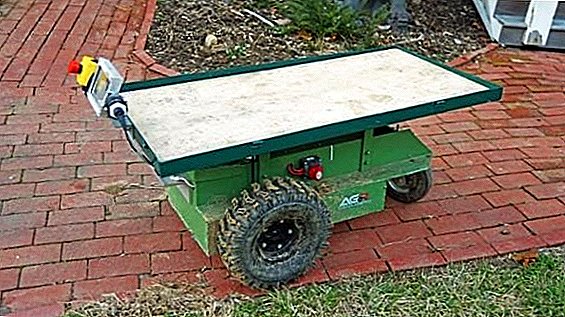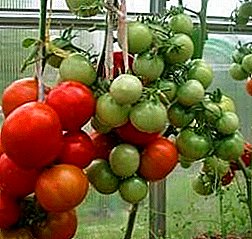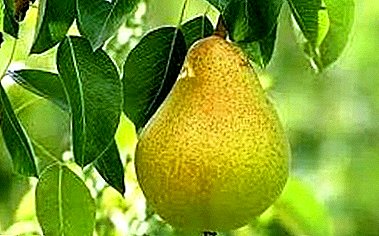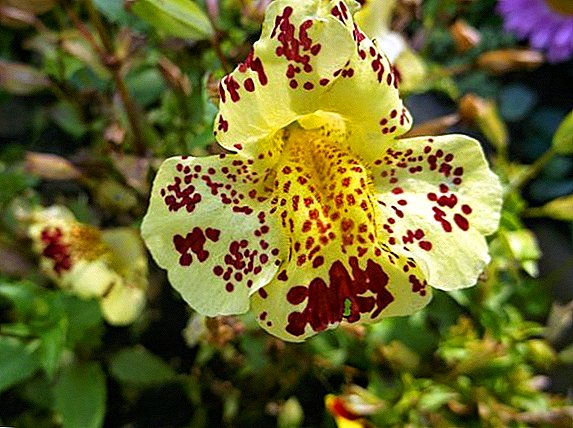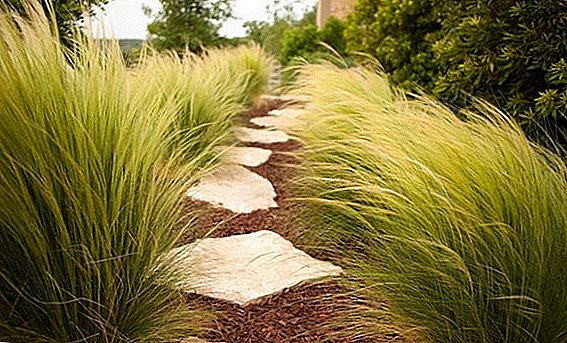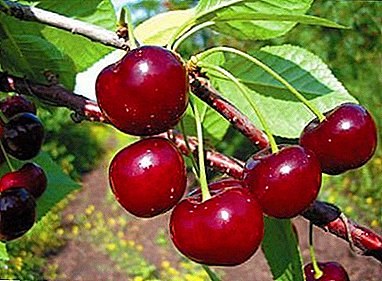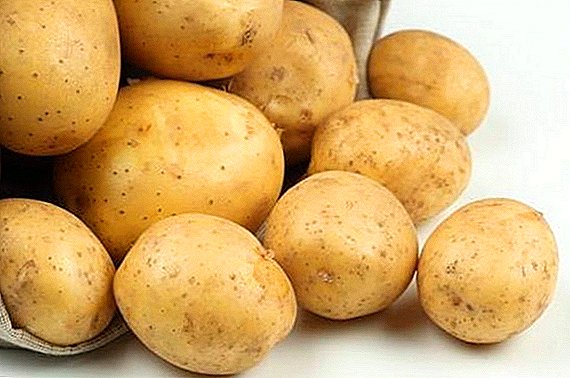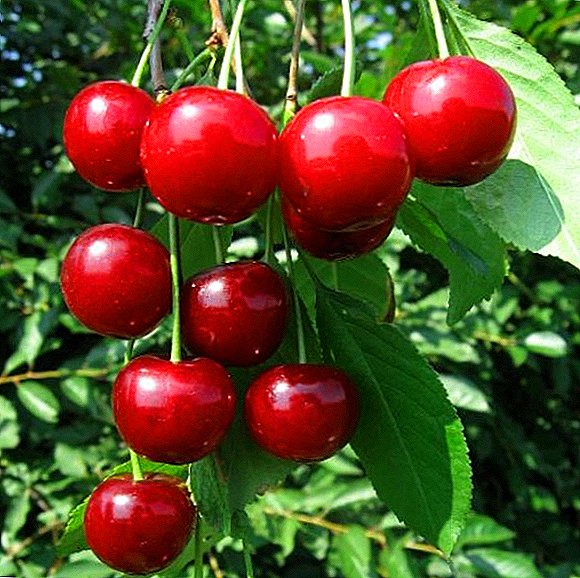 Cherry is one of the most common trees in our gardens. Its beautiful bloom fascinates in the spring, and delicious berries delight in early summer. However, to grow cherries in a harsh winter is not so easy. Fortunately, breeders have developed various varieties that tolerate the winter cold. These varieties include cherry "Dessert Morozova". From this article you will learn about the features of its cultivation and the main characteristics of the variety.
Cherry is one of the most common trees in our gardens. Its beautiful bloom fascinates in the spring, and delicious berries delight in early summer. However, to grow cherries in a harsh winter is not so easy. Fortunately, breeders have developed various varieties that tolerate the winter cold. These varieties include cherry "Dessert Morozova". From this article you will learn about the features of its cultivation and the main characteristics of the variety.
Selection
The cherry variety “Dessert Morozova” is a relatively young hybrid, since it was only in 1997 that it entered the State Register of the Russian Federation. In the same year he was allowed to cultivate in the Central Black Sea region.
This hybrid was created by the breeder T. V. Morozova at the All-Russian Research Institute for Horticulture them. Michurin. According to the information of the All-Union Scientific Research Institute, in the breeding seeds of Vladimirskaya variety were used, which were treated at the germination stage with aziridine, a chemical mutagen.
In the State Register of the Russian Federation, “Dessert Morozova” is called a descendant of the variety “Griot Ostheims” No. 2. The variety is obliged by the name to the breeder Morozova. She managed to combine the sweet taste and resistance of the culture to the winter cold, especially to the Russian frosts of the middle zone. 
Familiarize yourself with the characteristics and agricultural technology of cultivating such varieties of cherries as "Meeting", "Turgenevka", "Putinka", "Shpanka", "Vladimirskaya", "Zhukovsky", "Precious Carmine", "Winter Pomegranate", "Ashinskaya", " Mayak, Kharitonovskaya, Mayak, Morozovka.
Description and characteristics
This hybrid won the sympathy of many gardeners due to its unpretentiousness, excellent taste and early maturation. Let's take a closer look at its main characteristics.
Wood
Cherry "Dessert Morozova" - a relatively low tree (about 3 m), with a branchy spherical crown. The bark on the lower part of the trunk and the main knots has a light brown color, on young branches it is gray-green. Large shoots have an average number of lenticles.  Only young shoots are fruitful, in connection with this pruning of a tree it is necessary to pay special attention. In spring, medium-sized ovoid buds appear on the twigs, which are strongly deviated from the stem.
Only young shoots are fruitful, in connection with this pruning of a tree it is necessary to pay special attention. In spring, medium-sized ovoid buds appear on the twigs, which are strongly deviated from the stem.
They have a smooth relief and a matte surface with a light green color. The buds of this hybrid have no pubescence, like other plants. The leaves are rather large, similar in outline to an egg. Their surface is smooth, the stalk has an average length and thickness.
At the base of the leaf and on the handle there are 1-2 veins of red hue. The creeps of the “Dessert Morozova” cherry are short and fall off early. The foliage spreads over the crown evenly, but it is not so much. The leaves of this hybrid have a dull green color of light shades.
When the tree begins to bloom, it is covered with many large white flowers that exude a pleasant sweetish aroma. They are collected in inflorescences and have petals of a round shape, and pistils slightly protrude above the stamens. Flowers appear quite early, as the variety belongs to the early flowering. 
Fruits
After flowering, a berry is formed on the pedicel. The fruits of the "Dessert Morozova" large and juicy, bright red. If we look at the cherry in the light, you can see small subcutaneous dots. The flesh is very juicy, red in color and delicate texture. Stone rounded, medium size.
Did you know? Cherry is a rich source of coumarin (a substance that affects blood formation and improves blood clotting). For this reason, the berry will be useful for those who suffer from problems with blood clots or from various diseases of the heart and blood vessels.
The average weight of the berry is 4.6-5 g. It has an average depression near the stem and a barely noticeable abdominal suture. The stem is of medium thickness, and a separating layer forms at the border between it and the fruit.  Berries of the "Morozova Dessert" variety have a sweetish taste that looks more like the taste of sweet cherry. They contain more than 12% of sugars, and the tasting of the hybrid to taste was 4.6 out of 5 points.
Berries of the "Morozova Dessert" variety have a sweetish taste that looks more like the taste of sweet cherry. They contain more than 12% of sugars, and the tasting of the hybrid to taste was 4.6 out of 5 points.
Some features of the variety
"Morozova dessert" is not very different from other varieties, but still its cultivation has its own specifics.
Winter hardiness and disease resistance
This hybrid belongs to frost-resistant cultures. He quietly tolerates a drop in temperature to -40 ° C, which allows him to grow in the middle latitudes of our country. However, it does not tolerate a dry climate.
We recommend that you familiarize yourself with the methods of controlling diseases and pests of cherries.
This variety has an average resistance to diseases. According to the All-Russian Research Institute of Horticulture, when checking the stability of a hybrid for coccomycosis, he showed an average level of security.  For the prevention of this disease, an ash-salt solution (a mixture of ash, salt and laundry soap in a ratio of 6: 1: 1 is dissolved in 10 l of water), which is used in early spring, spraying iodine (10 ml per 1 bucket of water), treatment manganese solution (5 g manganese to 1 bucket of water).
For the prevention of this disease, an ash-salt solution (a mixture of ash, salt and laundry soap in a ratio of 6: 1: 1 is dissolved in 10 l of water), which is used in early spring, spraying iodine (10 ml per 1 bucket of water), treatment manganese solution (5 g manganese to 1 bucket of water).
Spraying with iodine and manganese is carried out three times. In this case, iodine treatment is used before budding with an interval of 3 days, and manganese - before flowering, after and during the ripening of the berries.
Important! If this tree do not carry out timely pruning, its leaves fall off and the branches become bare.
Pollinators
This variety has the property of self-pollinating, but at the same time, the yield of the tree does not exceed 20% of the total number of ovaries. That is why the most ideal way of pollination is group planting trees.  The best varieties for this are cherries "Student", "Vladimirskaya", "Griot Rossoshansky" or "Griot Ostgeymsky".
The best varieties for this are cherries "Student", "Vladimirskaya", "Griot Rossoshansky" or "Griot Ostgeymsky".
Ripening period and yield
In the third or fourth year of life, the tree begins to bear fruit. Berries begin to ripen in the twenties of June. Cherries bear fruit every year, while 35-40-40 kg of berries can be harvested from one tree. When grown in industrial conditions with 1 hectare, it is possible to collect approximately 60 centners.
Transportability
This variety is widespread due to good transportability. That is why the hybrid is often used for sale in various regions of the country, even the most remote. 
Direction
Thanks to the excellent taste qualities, the dessert variety Morozova fell in love with the confectioners and the sweet tooth. It is often used for making jams and preserves. And young children with great pleasure eat ripe and juicy berries for both cheeks, since this cherry has minimal acidity.
We advise you to read about how to make a liqueur, compote, tincture, cherry jam, as well as how to dry and freeze cherries.
Growing conditions
For successful cultivation, cherries need to be in the right place. So, the solar site protected from a wind and draft is best for landing. Ideal - near the south side of any building.
When choosing a place of cultivation, it is necessary to remember that the depth of groundwater should not be less than 1.5 meters. Otherwise, the root system decays and the plant begins to die.  Cherry "Dessert Morozova" prefers a neutral soil, which consists of subglinka (a mixture of clay and sand), sandy or sandy sandy soil.
Cherry "Dessert Morozova" prefers a neutral soil, which consists of subglinka (a mixture of clay and sand), sandy or sandy sandy soil.
Landing rules
Regarding the time of landing of this hybrid, there are two opinions. Some gardeners believe that the cherry can be planted in the fall. In this case, in the spring the seedling is already rooted and will develop better. Others - that it is better to plant a cherry in the open ground after the snow melted.
It will be useful for you to read about how to plant a cherry in the fall.
This will protect the plant from the effects of unexpected spring frosts, which can destroy a young, fragile tree.
It should be taken into account and what kind of seedling will be at your disposal. Young tree with an unprotected root system is best planted in the spring, but for containerized seedlings, planting time does not matter much. 
Important! It is better to choose a sapling by age from one to two years. In this case, the probability of successful engraftment increases.
When planting, it is necessary to determine the area of 3x3, where the tree will grow in the center. In this case, it will not intertwine with neighboring trees in the process of growth, and the root system will be able to develop freely.
A hole is dug in the center of this section, the depth of which should be 40-60 cm and a diameter of 50-60 cm. Some gardeners recommend digging a hole with a diameter of 80 cm, but this diameter is irrational, since the root system of the seedling is not so developed.
The soil, which is removed in the preparatory work, is mixed with mineral fertilizers and humus. In this way, the young plant will be nourished and better rooted. You can also apply fertilizer directly to the bottom of the fossa, for example, 2 tbsp. spoons of superphosphate.  However, in this case, before planting a seedling, it is necessary to pour a layer of earth over the fertilizers so that the roots do not get burned. To root rooted better, roots can be soaked in warm water, it will stimulate growth.
However, in this case, before planting a seedling, it is necessary to pour a layer of earth over the fertilizers so that the roots do not get burned. To root rooted better, roots can be soaked in warm water, it will stimulate growth.
Placing the seedling in the hole, you need to straighten the roots and cover them with earth. Having well tamped up the soil, a peg is driven in near the young plantings at a short distance, which will be maintained by an unstable seedling and will not interfere with growth.
Find out why you need soil mulching.
Around the cherries make a watering hole, which is poured into a few buckets of water, and a wet bud well mulch. A layer of mulch will retain moisture and protect the roots from drying out. The use of such a layer is very important in regions with a dry climate and the lack of opportunity to regularly water the sapling.
Video: planting cherries
Important! Experienced Gardeners recommend for better survival of cherries "Dessert Morozova" pick 80% of the foliage during the first year after planting.
How to care
Cherry "Desert Morozova" does not need special care. Caring for her as well as for other varieties.
Watering
Regular watering is required during awakening after winter and during budding, which is carried out 4 times a month, and more often if necessary (depending on climatic conditions).
When the tree begins to bloom, watering is reduced, and in the process of ripening berries, the soil is moistened as it dries. When excess liquid moisture accumulates in the berries, and they become much more watery, and consequently their transportability deteriorates.  Irrigation needs to be done in the morning and / or in the evening, pouring one bucket of water on a tree - then the liquid will evaporate less.
Irrigation needs to be done in the morning and / or in the evening, pouring one bucket of water on a tree - then the liquid will evaporate less.
Top dressing
After planting, organic fertilizers are applied not earlier than in 2-3 years, but mineral fertilizers are applied to the okolostvolnoy zone every fall. It is better to apply nitrogen fertilizers in early spring, as they stimulate the growth of cherries.
Potash is used before flowering, but closer to the fall is better to use phosphate fertilizers. Particular attention should be paid to feeding trees with potassium, as with its lack of plants cease to bear fruit.
It should be remembered that rich soil does not require frequent feeding, but the poor are recommended to be fertilized annually.
Video: how and how to fertilize fruit trees
Important! Once in 6 years, the Morozova Dessert cherry needs to be fed with lime, which is introduced into the root area, in the amount of 200-400 g.
Soil care
The land around the trunk must be regularly loosened. This allows you to make the soil more airy, and moisture will easily and quickly penetrate to the roots. Periodically, the stalk zone should be weeded, removing young shoots and weeds.
Pruning
It is important to pay special attention to proper pruning, as it may affect the yield of the tree. Cherry "Desert Morozova" is cut for the first time right after planting, which allows you to form a crown, and in the future - each spring before the buds dissolve.
We advise you to familiarize yourself with the rules of cutting cherries in spring and autumn.

It is necessary to cut the branches at the very base so that hemp does not form. Shoots that are directed towards the ground or spread along it must be cut completely. Regular thinning of the crown helps to protect the tree from parasites and diseases.
Young shoots are also pruned, leaving only smooth and healthy. However, one should not get involved in such a procedure either, because excessive pruning takes a lot of energy from the plant and inhibits its development. Cherry, which has reached three years of age, is limited in growth, pruning her upper shoots.
Preparing for the winter
Due to the high degree of frost resistance, the "Dessert Morozova" cherry does not need additional shelter. However, the tree is not protected from rodents, therefore the trunk of a cherry is wrapped up and a wire fence is installed.
Experienced gardeners in the winter period throw drifts under the crown of the tree - this reduces the impact of spring frosts on the root system.
Video: how to properly prepare fruit trees for winter
Advantages and disadvantages
Advantages thanks to which this hybrid was widely adopted among gardeners:
- winter hardiness;
- early maturation;
- good taste;
- high yields;
- regular fruiting;
- good resistance to diseases and pests;
- high rates of transportability.
Did you know? The world famous Japanese Sakura is an inedible variety of cherry, valued only for its beauty.
Disadvantages of the variety "Dessert Morozova":
- in the absence of proper pruning, leaves fall;
- resistance to coccomycosis has averages.

Did you know? Cherry tinctures and liqueurs surprise no one. However, in our area, few people know that in Belgium is very popular ... cherry beer. For its production ripe cherries are kept for a long time in lambic, a traditional beer based on barley and wheat."Dessert Morozova" is a variety that combines sweet taste, good yield and cold resistance. It can be used for growing on the plot, and for industrial purposes, besides, it is quite unpretentious in the care. This sort of cherry will not only be a great decoration for your garden, but also a worthy guest at every table.



